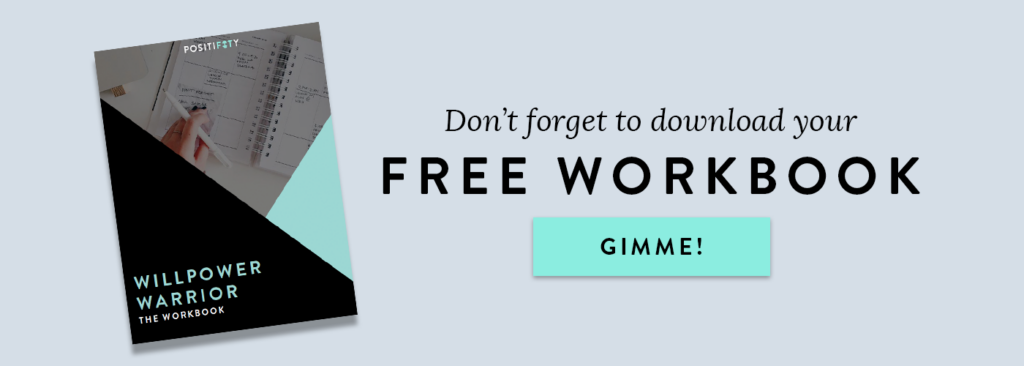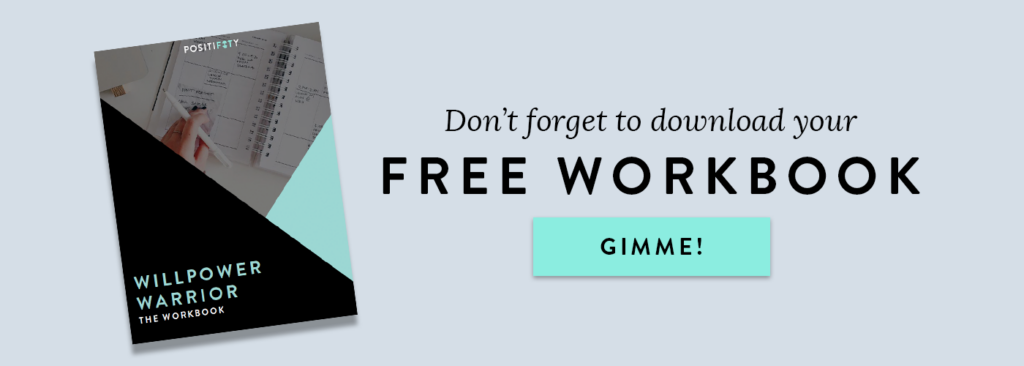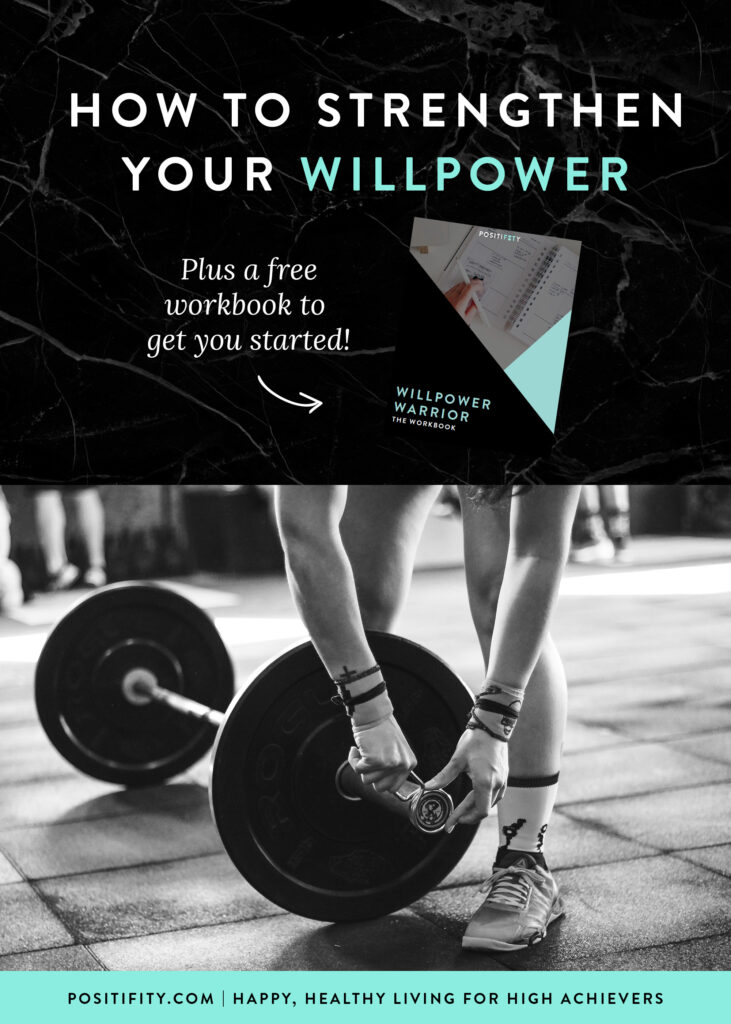On this blog, I share practical tips, tools, and strategies to help you reclaim and AMPLIFY your energy so you can banish burnout and start experiencing more clarity, freedom and flow!
hey!
Energy
Health
Productivity
Vision

Have you ever felt like you know exactly what you want achieve, but every time you sit down and try to actually, ya know, DO it your willpower is suddenly nowhere to be found?
If so, then you’re in the right place. In this post we’re going to delve into the strategies you can use to master your willpower so that you can finally start making progress on your most important goals and getting the results that you want in your life.
Is Willpower Something You’re Born With?
In the famous Marshmallow Test experiment, psychologist Walter Mischel studied delayed gratification in children.
The experiment went like so: A researcher presented a preschooler with a single marshmallow and gave them a simple choice. The researcher was going to leave the room for a few minutes, and the child could either eat the marshmallow they’d been given OR wait until the researcher returned and receive an additional marshmallow.
The results were pretty hilarious.
Follow-ups with the children from the experiment during adolescence and in mid-life suggested that the ability (or lack thereof) to delay gratification was persistent and predictive of what the individual would achieve in school and in life.
So if you feel like you’re lacking in willpower, should you just throw in the towel now?
Nope.
The key takeaway Mischel discovered was that it isn’t so much a natural trait that allows you to resist short-term gratification, but rather your coping mechanisms which are a set of skills that can be learned.
That’s good news for us.
Your Willpower Warrior Gameplan
First things first, make sure you download your Willpower Warrior Workbook to guide you through applying the strategies outlined in the following 6 steps to your life.

Got it? Okay, good. Let’s get started!
Step 1: Start thinking of willpower like a muscle
Think for a moment about training your biceps. When you first begin your workout, cranking out a set of bicep curls may feel easy breezy, but by that third set, your muscles are fatigued and each rep becomes significantly harder, even if you’re still lifting the same amount of weight.
Willpower works in a similar way. Each time you exert self-control you are left with a little less willpower to resist the other temptations that you will encounter throughout the course of your day.
So, for example, if you exert a lot of willpower trying to successfully stay on task in the office all day when you really just want to binge watch TikTok videos, it’s going to be much harder to muster up the willpower needed that evening when you’re trying to say no to the cupcakes sitting on your kitchen counter.
This goes hand in hand with the principle of “decision fatigue” which says that the quality of the decisions made by a person declines as they make more and more decisions throughout the day.
Now that you know this, what can you do about it?
1. BATCH OR ELIMINATE AS MANY TASKS FROM YOUR DAY-TO-DAY AS POSSIBLE
This could be:
- Answering all of your emails at one pre-determined time rather than immediately as they come into your inbox
- Meal-prepping your food for the week in advance (Because, let’s be honest, despite our best intentions, how often are poor food choices the consequence of drained willpower?)
- Creating a solid routine to jumpstart your mornings so that you don’t have to make several on-the-fly decisions about how to proceed each day
2. START SMALL
You wouldn’t go to the gym for the first time and head straight for the 100 pound dumbbells.
Even if lifting those bad boys was your ultimate goal, you’d first start with a more manageable weight and slowly work your way up.
It seems obvious in the context of the gym, but this zero to 100 approach is exactly how most people approach their goals.
Knowing that your willpower is limited, don’t try and make too many massive changes or take on too many demanding tasks at once.
Instead, focus your willpower on a few (ideally ONE) meaningful goals at a time, and you will accomplish more in the long-run.
3. DO YOUR MOST IMPORTANT TASK FIRST EACH DAY
Because your willpower decreases with each decision that you make, it makes sense to do your most important work BEFORE the effects of decision fatigue really start to set in.
It may be tempting to knock those easier items off your to-do list, but it could undermine your ability to complete the most important tasks that are ultimately going to move you towards your goals.
Step 2: Building Awareness – It’s Time to Get Real With Yourself
Before you can work on strengthening your willpower, you first need to have a really clear understanding of where your willpower is being used now, where you’d like to exert more of it, and why you want to exert it there.
Use the following questions as a starting point to gain some insight into why you’re struggling to muster up willpower where it’s most needed.
You can find space to reflect on these questions on page 5 of your workbook.
- Are you trying to lift too heavy of a weight for your current capabilities (figuratively or literally)? Do you need to break up an overwhelming goal into even smaller, more manageable pieces?
- Are you trying to tackle too many new challenges at once? Do you need to narrow your focus?
- Is the goal or behavior you want to adopt personally meaningful to you? If not, can you re-frame the goal/behavior to make it so?
- Is fear or self-doubt keeping you from giving your best effort?
- Are you letting unimportant tasks or other people’s priorities drain your willpower reserves or are you consciously deciding where to apply your effort and prioritizing your time accordingly?
- Are you giving your best energy to the most important tasks with the highest ROI or are you focusing on the minutiae and becoming frustrated because you aren’t seeing results? In the lifting world, this would be the equivalent of someone with the goal of building more muscle focusing all of their attention and energy on consuming the right supplements, instead of the most important action – actually lifting the weights.
- Is there information or resources that you need to be able to take the next step? If so, how can you get them?
Step 3: Identify what is currently hijacking your willpower
How many times have you sat down to work when a random question occurs to you and so you think, “Oh I’ll just Google it really quick” and then – 5 blog posts, 3 YouTube videos, and a scroll through Instagram later – you realize that an hour has gone by and you haven’t even started what you sat down to do?
If you’re anything like me, the answer is A LOT.
As you go about your week, use the chart on page 7 in your Willpower Warrior Workbook to take note of what derailed your efforts each time that you find yourself off-task or cave to temptation.
Once you have an idea of the specific distractions and triggers that are getting you off track, you can then work on creating systems to manage them or eliminate them altogether.

Step 4: It’s time to create your Willpower Warrior Gameplan!
So if you’ve followed steps 1-3, you’ve identified your most important goal and figured out what is draining your willpower.
In this step, we’re going to form a plan to tackle the obstacles that are preventing you from making the progress that you’d like toward your goal(s).
1. OPTIMIZE YOUR ENVIRONMENT FOR SUCCESS
Are the things that distract you or get you off-track things that you can eliminate from your environment?
For example, if your goal is to eat healthier foods but, despite your best efforts, you constantly find yourself in the pantry, reaching for the bag of chips – Can you get rid of or give away the foods that you’d like to avoid snacking on in your home? Can you make them less accessible some other way?
If social media notifications constantly get you off track when you sit down to work, can you turn off all notifications so that you’re only aware of them when you choose to be? Can you install an app on your computer that blocks you from visiting distracting sites for a certain period of time? Can you keep your phone tucked away in a drawer or in another room while you work?
In addition to eliminating or reducing the impact of negative temptations in your environment, you should also look for ways to make desirable behaviors easier.
For example, sitting out your workout gear the night before, if you want to hit the gym in the AM or keeping nutritious meals prepped and ready to go so that the healthy option becomes the “easy” option in those moments when you’re dying of hunger or in a rush and can’t be bothered to cook.
2. CREATE IF-THEN RULES
A common mistake people make (myself included) is trying to apply willpower in an unspecific way to vague goals. If your goal is to “get in shape” or to “go to the gym more”, what does that really mean?
If you want to see results, then you need to get specific about how you will accomplish your goals and react to potential obstacles.
One way to do this is creating if-then rules, which take the format “If X, then I will do Y.”
X can be anything from a specific time and day (i.e. “If it’s Tuesday at 7 AM, I will go to the gym and workout for 1 hour”) or a specific event or situation (i.e. “If I go out with friends on Friday night, I will limit myself to one drink”).
By establishing clear rules in your life, you conserve your willpower for other important choices, while making it easier to make the right decision in areas of significance to you.
In fact, research shows that you are 2-3 times more likely to succeed if you use an if-then plan than if you don’t.
3. DETERMINE YOUR METRIC FOR SUCCESS & MONITOR YOUR PROGRESS
One of the most important steps in harnessing your willpower is choosing a metric relevant to your goal or desired habit and tracking it consistently.
So, going back to the example goal of “getting in shape” – maybe you decide that you will go to the gym 4 days per week, and you print off a calendar and mark it with an “X” each day that you complete a workout session.
Perhaps you decide you need to clean up your diet, and so you begin recording what you eat using an app like MyFitnessPal.
As Tim Ferriss said, “The act of measuring is often more important than what you measure.”
Even more than the raw data, this practice is about bringing awareness to your current behaviors and being able to see your progress in a tangible way.
The metric that you choose should be something that you can directly control with your behavior. In other words, your metric should focus more on the process rather than the outcome.
For example, if your goal is to lose weight, you CAN control how many days you show up at the gym each week. You CAN’T directly control how much weight you will lose.
The beauty of these types of process-oriented metrics is that by focusing on the behavior you can directly control, you will most likely see progress towards the outcome that you can’t.
Step 5: Recognize the importance of rest and recovery for recharging your willpower reserves
To think about rest and recovery as it applies to willpower, let’s return to the muscle analogy.
When you’re working to strengthen a muscle through your workout program, there are two important ways that rest comes into play.
One is taking short breaks between sets during your workout in order to allow your muscle to recover before going at it again. If you try and do one straight set of 24 reps without a break, you’re not going to be able to lift as much total weight as if you’d broken that up into 3 sets of 8 reps with a 90 second rest period in between.
This is comparable to sitting in an office or studying in the library and trying to work for 8 hours straight with no breaks. Eventually you become mentally drained, your willpower is depleted, and the quality of your work suffers as a result.
However, by adding short, strategically timed breaks to your day (I personally use a modified version of the Pomodoro technique), you give yourself the opportunity to recharge so that you can return to your work with renewed focus and energy.
How can you start incorporating periods of rest into your day (even if they’re only 5 minutes) to recharge when you start to feel yourself slipping into a slump?
The second important form of rest and recovery in a strength-training program is allowing 48-72 hours for the fatigued muscle(s) to repair and rebuild post-workout.
When it comes to willpower, this is similar to regularly carving out time for self care.
We often view self care as a “reward” or a self-indulgent luxury, but in fact, it’s a key part of performing optimally. Self-care prevents burnout and reduces the negative effects of stress.
Whether it’s 5 minutes of meditation before bed, a rest day from the gym or a weekend get-away where you unplug from work and technology, it’s incredibly important to include intervals of recovery time where your willpower isn’t being maximally taxed.
Step 6: Fuel Yourself for Success
As Kelly McGonigal, author of The Willpower Instinct, said, “Willpower can be disrupted by sleep deprivation, poor diet, a sedentary lifestyle, and a host of other factors that sap your energy, or keep your brain and body stuck in a chronic stress response. To every doctor, diet guru, or nagging spouse convinced that willpower is just a matter of making up your mind, this research should be a reality check. Yes, your mind is important, but your body also needs to get on board.”
Willpower has just as much (or more) to do with the state of your body as it does your mind, so it’s critical to make sure that you’re making time for exercise, fueling your body with healthy foods, and getting enough sleep each night.
These are things that we all know we should do, but are often the first to get scrapped when life gets busy. The irony is that these are also the behaviors that have the most power to boost our productivity and add time to our life over the long-term.
Don’t discount their significance to accomplishing your goals and performing optimally in non-health-oriented areas of life.
Ready to become a Willpower Warrior?
So there you have it – your 6 step plan to becoming a Willpower Warrior! If you haven’t already, be sure to download your Willpower Warrior Workbook to get started on applying these strategies so you can start seeing the results that you want in your life.

NOW I WANT TO HEAR FROM YOU!
What are your biggest willpower struggles? What willpower hacks do you use to resist temptations and stay focused on your goals? Let me know in the comments below!

PIN IT FOR LATER

Related Posts
On this blog, I share practical tips, tools, and strategies to help you reclaim and AMPLIFY your energy so you can banish burnout and start experiencing more clarity, freedom and flow!
hey!
Energy
Health
Productivity
Vision
READY TO TAKE YOUR HUMAN DESIGN EXPERIMENT TO THE NEXT LEVEL?
Download Your FREE 2025
Human Design Transit Calendar & Guide
BE THE FIRST TO KNOW WHEN NEW RESOURCES DROP.
CONTACT
GET YOUR CHART
FREE TRANSIT GUIDE
COPYRIGHT © 2025 OPTIMIZE FOR FREEDOM, LLC. All rights reserved. LEGAL.